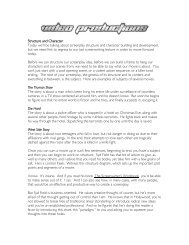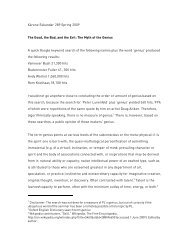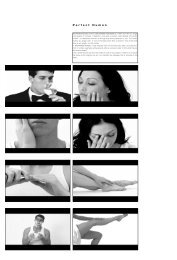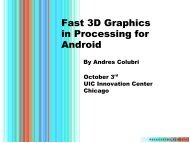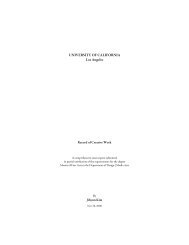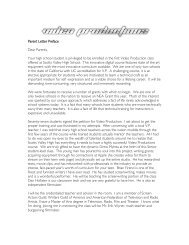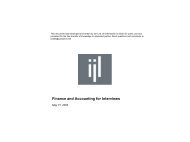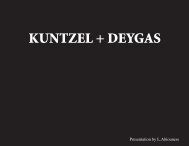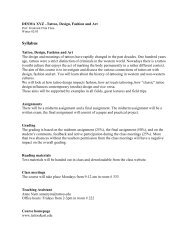Singing cells, art, science and the noise in between - Users - UCLA
Singing cells, art, science and the noise in between - Users - UCLA
Singing cells, art, science and the noise in between - Users - UCLA
You also want an ePaper? Increase the reach of your titles
YUMPU automatically turns print PDFs into web optimized ePapers that Google loves.
Comments about digital media projects, such as “There is no content! It doesn’t have any<br />
depth”, recently uttered by a <strong>UCLA</strong> Professor of <strong>the</strong> traditional <strong>art</strong>s may lead to <strong>the</strong><br />
presumption that noth<strong>in</strong>g has changed <strong>in</strong> <strong>the</strong> past 40 years s<strong>in</strong>ce C. P. Snow’s <strong>the</strong>sis of<br />
<strong>the</strong> two cultures. 36 One may ask oneself how <strong>the</strong> conservative m<strong>in</strong>dset was able to ignore<br />
<strong>the</strong> gigantic impact of technology on society <strong>and</strong> culture.<br />
O<strong>the</strong>r examples, as well, demonstrate <strong>the</strong> strong belief <strong>in</strong> <strong>the</strong> division of discipl<strong>in</strong>es.<br />
When <strong>the</strong> group of scientists from <strong>the</strong> <strong>UCLA</strong> chemistry dep<strong>art</strong>ment, <strong>in</strong>clud<strong>in</strong>g my<br />
collaborator Andrew Pell<strong>in</strong>g, first proposed <strong>the</strong>ir paper on <strong>the</strong> discovery of cellular audio<br />
to various scientific magaz<strong>in</strong>es, <strong>the</strong>y were rejected with arrogant comments, stat<strong>in</strong>g that<br />
<strong>the</strong> discovery was non-credible <strong>and</strong> might be of <strong>in</strong>terest to <strong>art</strong>ists, but not to <strong>science</strong>. Here<br />
we see <strong>the</strong> tendency to ma<strong>in</strong>ta<strong>in</strong> <strong>the</strong> borders of discipl<strong>in</strong>es, ma<strong>in</strong>ta<strong>in</strong> specialization <strong>and</strong><br />
<strong>the</strong> <strong>in</strong>contestable authority of <strong>science</strong>, ignor<strong>in</strong>g <strong>the</strong> benefit brought <strong>in</strong> recent years to <strong>the</strong><br />
scientific underst<strong>and</strong><strong>in</strong>g of matter by sound-related approaches. Meanwhile <strong>the</strong> research<br />
of cellular audio receives <strong>in</strong>ternational recognition of <strong>the</strong> <strong>science</strong> community, but it did<br />
take more than two years to achieve this. 37<br />
And <strong>in</strong>deed, tear<strong>in</strong>g down borders requires extreme measures as well as time. Whereas a<br />
media <strong>art</strong>ist <strong>and</strong> a computer scientist, for example, might f<strong>in</strong>d little problems <strong>in</strong><br />
communicat<strong>in</strong>g <strong>and</strong> collaborat<strong>in</strong>g, <strong>the</strong> divide <strong>between</strong> <strong>the</strong> perception of <strong>the</strong> world by a<br />
chemist <strong>and</strong> a writer could rema<strong>in</strong> unbridgeable for a long time. The establishment of a<br />
common ground can be advanced by <strong>the</strong> fact that both discipl<strong>in</strong>es deal with technological<br />
methods, which I found true for <strong>the</strong> group work<strong>in</strong>g on <strong>the</strong> NANO project, but does not<br />
necessarily guarantee a common basis, which I realized through my <strong>in</strong>teractions with<br />
members of <strong>the</strong> <strong>UCLA</strong> computer <strong>science</strong> dep<strong>art</strong>ment. Some discipl<strong>in</strong>es are said to be<br />
closer to each o<strong>the</strong>r through common characteristics, for <strong>in</strong>stance ma<strong>the</strong>matics <strong>and</strong> music,<br />
but my personal experience leads me to <strong>the</strong> conclusion that <strong>the</strong>se relations are mere<br />
generalizations that cannot be counted on for collaboration.<br />
Stephen Wilson po<strong>in</strong>ts out that ma<strong>the</strong>matics takes a special role <strong>in</strong> <strong>the</strong> discussion of <strong>art</strong><strong>science</strong><br />
<strong>in</strong>tersect<strong>in</strong>g, as it has a “dual identity”: pure <strong>and</strong> applied ma<strong>the</strong>matics. Although<br />
<strong>the</strong> high level of abstraction gives pure ma<strong>the</strong>maticians “<strong>the</strong> opportunity to dream up<br />
arbitrary worlds with <strong>the</strong>ir own <strong>in</strong>ternally consistent rules unfettered by connections with<br />
<strong>the</strong> conventional world”, which is ak<strong>in</strong> to <strong>art</strong>istic practice, I have found that pure<br />
ma<strong>the</strong>maticians <strong>and</strong> logicians ma<strong>in</strong>ta<strong>in</strong> a conservative perspective that ends <strong>the</strong>ir<br />
recognition of <strong>art</strong> <strong>and</strong> music with <strong>the</strong> Renaissance period as often as o<strong>the</strong>r scientists. 38<br />
In NANO, <strong>the</strong> <strong>the</strong>ory of <strong>the</strong> “two cultures” was aga<strong>in</strong> enforced by <strong>the</strong> fact that <strong>the</strong><br />
p<strong>art</strong>icipat<strong>in</strong>g media <strong>art</strong>ists <strong>and</strong> chemists had little problems collaborat<strong>in</strong>g, but both had to<br />
contend with <strong>in</strong>flexible members of <strong>the</strong> literature group. The chemists were disappo<strong>in</strong>ted<br />
by <strong>the</strong> humanists’ tendency to hold on to “outdated” views of <strong>science</strong> derived from<br />
36 Quote by Prof. Herman, taken from The Daily Bru<strong>in</strong>, <strong>UCLA</strong> campus newspaper, Feb. 12, 2004, p. 7<br />
37 Local Nanomechanical Motion of <strong>the</strong> Cell Wall of Saccharomyces cerevisiae by Andrew E. Pell<strong>in</strong>g,<br />
Sadaf Sehati, Edith B. Gralla, Joan S. Valent<strong>in</strong>e, James K. Gimzewski, published <strong>in</strong> Science, Vol. 305,<br />
Issue 5687, 20 August 2004: http://www.<strong>science</strong>mag.org/cgi/content/abstract/305/5687/1147<br />
38 Information Arts, Stephen Wilson, Cambridge, Massachusetts: The MIT Press, 2002, p. 298<br />
13



